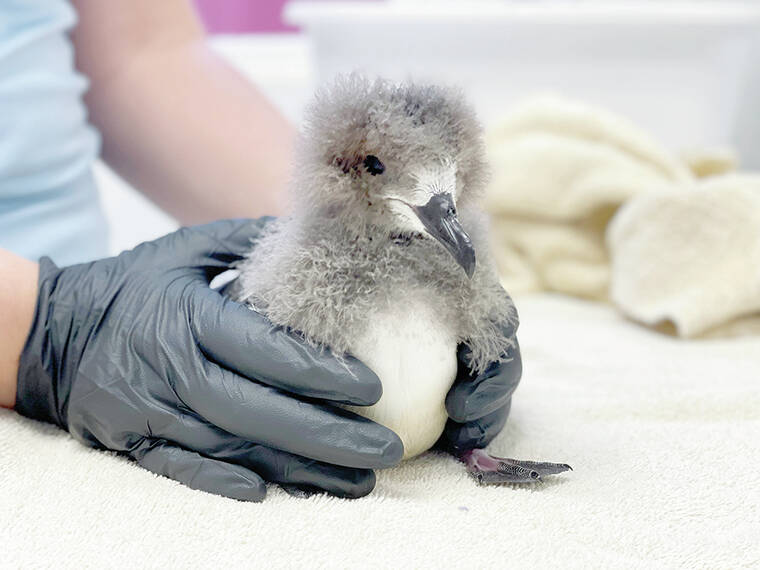WAIMEA — A fallout-stricken seabird has returned to the wild following its rescue by experts who spied the struggling animal while conducting a survey of seabirds passing over powerlines.
Personnel from ecological consultancy Archipelago Research and Conservation caught the federally-threatened ‘a‘o, or Newell’s shearwater (Puffinus auricularis newelli), on a thermal camera.
Black-and-white footage of the event shows the ‘a‘o flap its wings from atop a chain-link fence, before making a short, failed attempt at flight.
“It was just good luck that I saw this bird through the thermal camera,” ARC staff member Marc Travers said in a Tuesday press release. “… Even with the added lift, it still ended up crashing back to the ground.”
The ‘a‘o was suffering from fallout, which occurs when seabirds are disoriented by bright, artificial lights as they attempt to navigate at night.
On Kaua‘i, peak fallout season runs from Sept. 15 through Dec. 15, when young shearwaters and petrels take flight for the first time.
The seabirds’ physiology makes take-off from dry land next to impossible without a steep slope or cliff, according to ARC Science Director André Raine.
“‘A‘o have a body structure that makes them perfectly adapted for pursuing prey underwater – they literally fly underwater to chase fish and squid up to 150 feet down,” Raine told The Garden Island. “For birds, there’s a trade-off between flying underwater and flying through the air, penguins being the most extreme example.”
The ‘a‘o’s torpedo-like body is fitted with relatively short wings that are designed for rapid wing beats, Raine explained.
Because of this, the birds must launch themselves from the slopes and cliffsides where they nest, dropping through airspace before their wings flap fast enough to fly.
“If they don’t have enough space in which to drop, they hit the ground, like this bird did,” Raine said of the Waimea ‘a‘o. “So, for the vast majority of grounded ‘a‘o that get attracted to lights, once they are down, they are doomed unless someone rescues them.”
Raine believes the Waimea ‘a‘o had probably been grounded the night before its discovery by ARC, having spent the preceding day hiding in a dark space.
ARC took the bird to native wildlife-rehabilitation facility Save Our Shearwaters in Lihu‘e, which designated the dirty, dehydrated animal NESH IMMP327.
IMMP327 was in otherwise good condition and flew out to sea the following day, following a brief rehabilitation process.
Petrel improving
A federally-endangered ‘ua‘u, or Hawaiian petrel (Pterodroma sandwichensis) chick delivered to SOS in October is getting ready to fly.
The young bird, whose rescue from a flooded burrow was covered by The Garden Island, initially had low weight, a distended stomach and potentially ruptured subcutaneous air sacs located along its sides.
Its fate, at the time, was uncertain.
But on Wednesday, SOS Program Coordinator Molly Bache reported the petrel known as MMJ122 could fledge in the next two weeks.
“(It’s) still in care and doing great,” Bache said.
•••
Scott Yunker, reporter, can be reached at 245-0437 or syunker@thegardenisland.com




